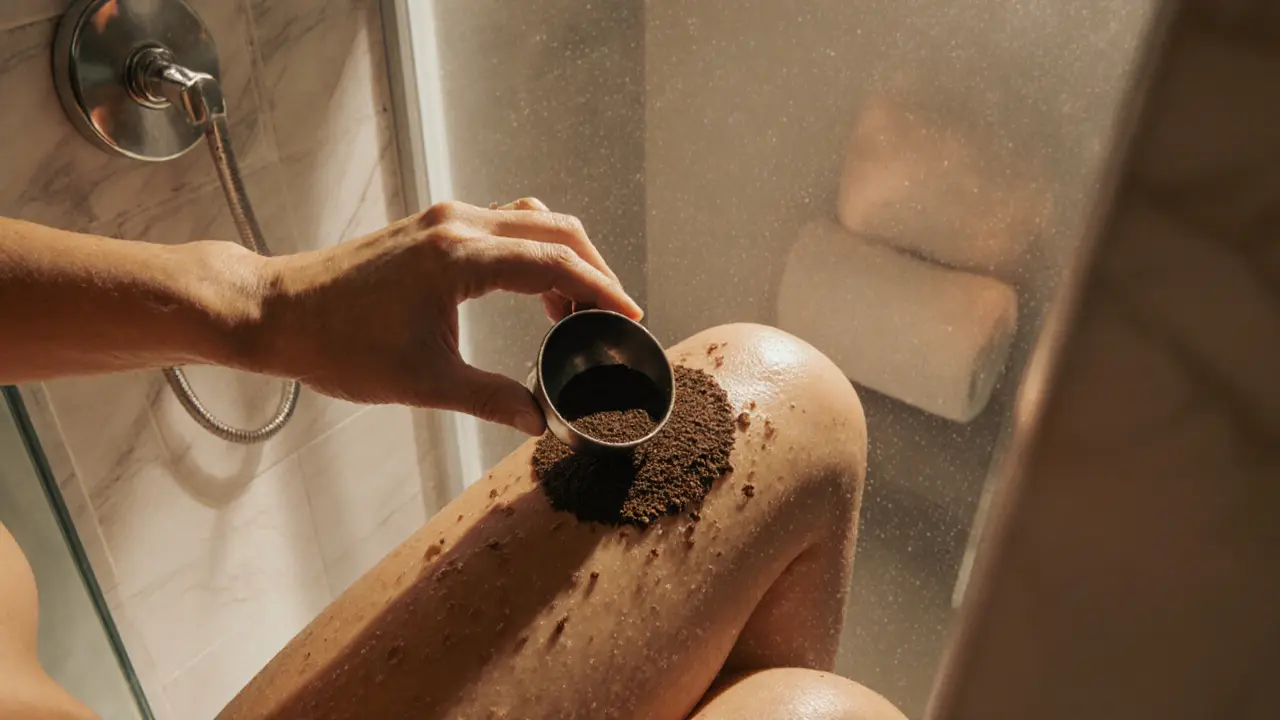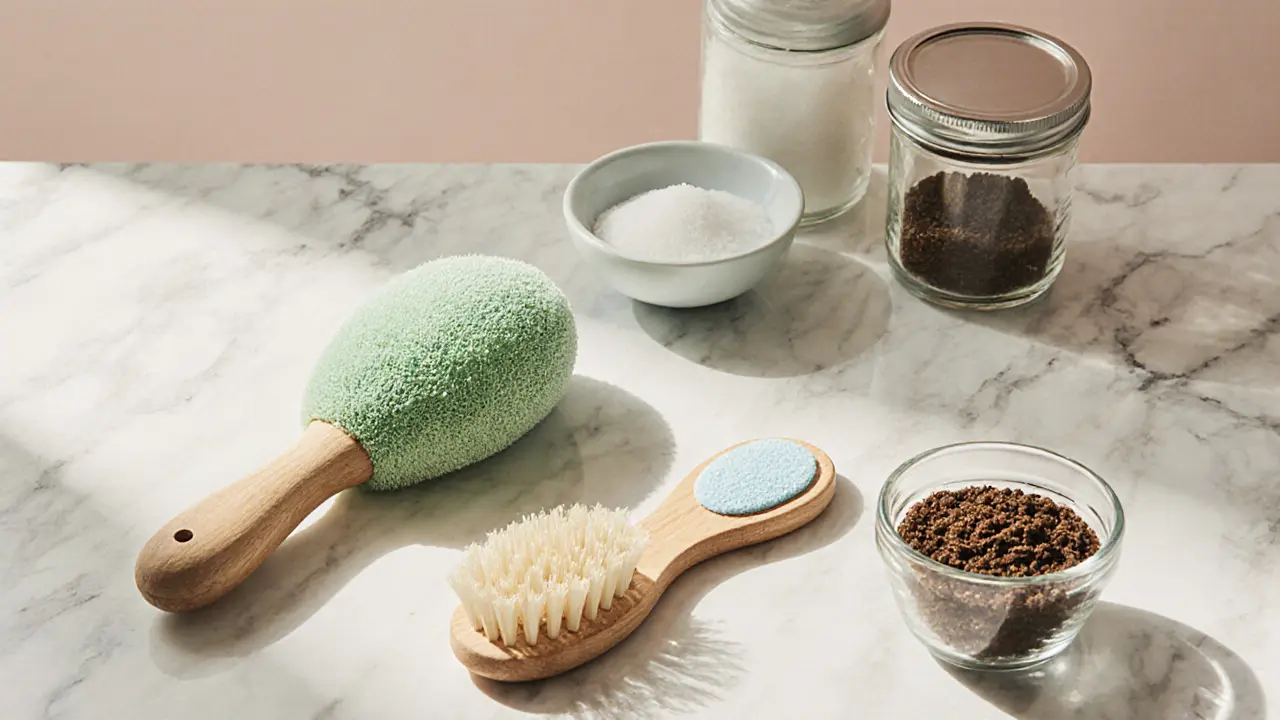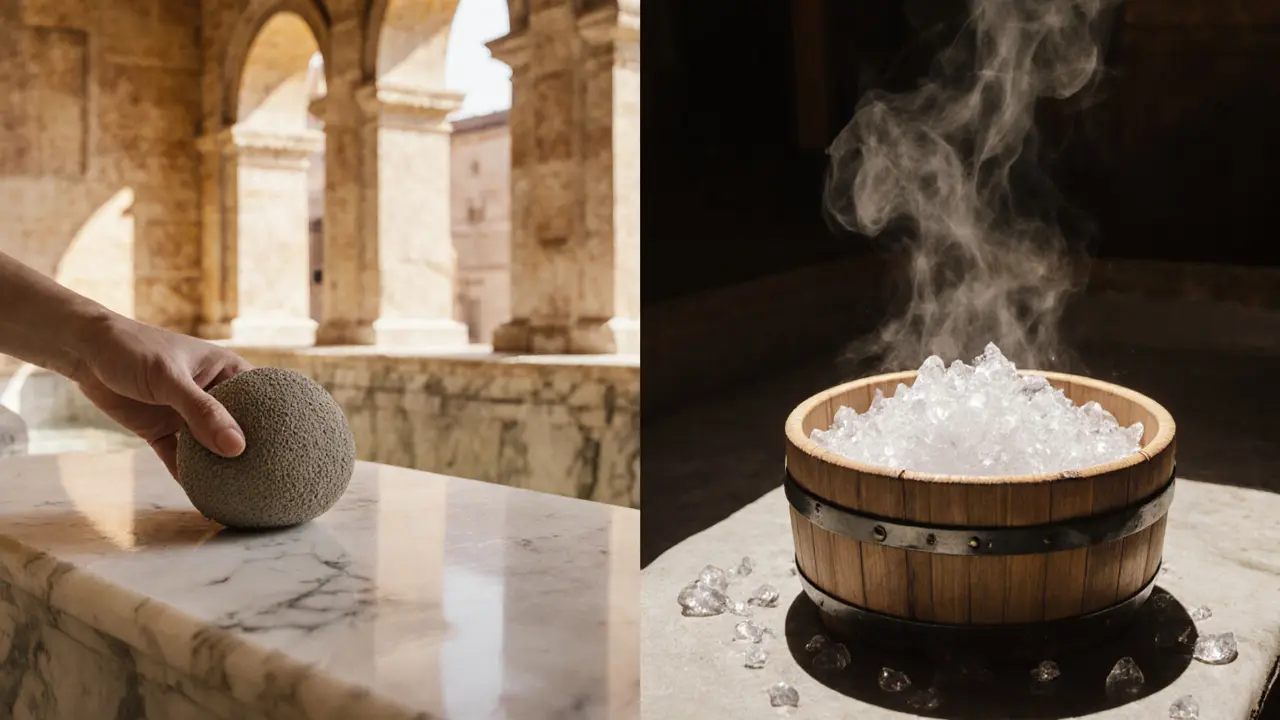When it comes to getting that silky‑smooth glow, choosing the best body scrubber can feel like a guessing game. Below you’ll get a straight‑to‑the‑point guide that walks you through the most common scrubbers, how they work, and which one fits your skin and lifestyle.
Understanding the Basics of Body Scrubbing
Origins and History
Around the world, exfoliation has been part of beauty rituals for centuries. Ancient Romans used pumice stones, while Japanese onsen baths relied on sea salt. Modern body scrubbers evolved from those raw ingredients into the polished products you see on shelves today.
Core Principles or Components
At its core, a body scrubber combines abrasive particles (like salt, sugar, or coffee grounds) with a carrier (oil, butter, or gel). The particles physically slough off dead skin cells, while the carrier moisturizes and eases the friction.
How It Differs from Related Practices
Scrubbing is a manual, physical method. It’s distinct from chemical exfoliants (AHAs/BHAs) that dissolve bonds, and from professional micro‑dermabrasion devices that use vibrating heads. Below is a quick side‑by‑side view.
| Method | How It Works | Typical Use |
|---|---|---|
| Physical Scrubber | Abrasive particles manually rubbed on skin | Home routine, 1-2×/week |
| Chemical Exfoliant | Acids dissolve dead‑cell bonds | Serums, 2-3×/week |
| Microdermabrasion | Vibrating tip with fine crystals | Spa treatment, monthly |
Who Can Benefit from Body Scrubbing?
Everyone from teen skin‑care newbies to seasoned spa goers can gain. If you struggle with rough patches, clogged pores, or simply love the feeling of clean skin, a scrubber fits. Sensitive‑skin folks should start with milder particles (like sugar) and limit frequency.
Benefits of Body Scrubbing for Your Skin
Improved Skin Texture
By removing the outermost dead cells, scrubbers smooth out uneven texture and reduce the appearance of dry spots. The result is a more even canvas for moisturizers and sunscreen to work.
Boosted Circulation
Massaging the skin with a scrubber stimulates blood flow. Better circulation means more oxygen and nutrients reach the skin, which can promote a healthy glow.
Enhanced Product Absorption
When you wipe away the flaky layer, creams and oils sink in faster and deeper, giving you more bang for your buck on every moisturizer.
Stress Relief
Believe it or not, the rhythmic motion of a good scrub feels therapeutic. It’s a mini‑massage that can lower tension and improve mood.
| Benefit | Description | Impact |
|---|---|---|
| Smoother Texture | Removes dead cells | Improved skin feel |
| Better Circulation | Gentle massage effect | Healthier glow |
| Higher Absorption | Pre‑ps the skin | Moisturizer works better |
| Stress Relief | Relaxing ritual | Calmer mind |
What to Expect When Using a Body Scrubber
Setting or Context
Most people do a scrub in the shower or bath, where water provides slip and rinses away particles. Warm water opens pores, making the process more effective.
Key Processes or Steps
- Wet skin and the scrubber.
- Apply a small amount of product (a dime‑size pea‑sized amount works).
- Massage in circular motions, 1-2 minutes per area.
- Rinse thoroughly, then pat dry.
- Follow with a hydrating lotion or oil.
Customization Options
You can vary particle size, scent, and added ingredients (like essential oils or caffeine). Some scrubbers are formulated for specific needs-dry skin, cellulite, or firming.
Communication and Preparation
If you’re booking a spa treatment, let the therapist know about any skin conditions, allergies, or recent sun exposure. At home, read the label for any contraindications.
How to Choose and Use the Right Body Scrubber
Setting Up for Success
Create a calm space: dim the lights, play soft music, and have a towel ready. A tidy shower area prevents slipping.
Choosing the Right Tools
Below are the most popular scrubbers, each marked up with microdata for quick reference.
- Salt Scrub - coarse crystals, great for oily skin and cellulite.
- Sugar Scrub - softer grains, suitable for dry or sensitive skin.
- Coffee Scrub - contains caffeine, claims to reduce appearance of cellulite.
- Loofah - natural plant fiber, provides a gentle physical exfoliation.
- Dry Brush - firm bristles, used dry before shower to boost circulation.
- Microdermabrasion Tool - electric device with fine crystals, for at‑home spa‑level exfoliation.
Step‑by‑Step Guide for a Home Scrub
- Start with warm water; the steam opens pores.
- Take a pea‑sized amount of your chosen scrub.
- Apply to damp skin, using circular motions. Focus on elbows, knees, and any rough spots.
- Don’t scrub more than 2 minutes total - over‑exfoliating can irritate.
- Rinse thoroughly, then apply a generous layer of moisturizer or body oil.
Tips for Beginners or Couples
If it’s your first time, start with a sugar scrub once a week. For a couple’s spa night, each partner can use a loofah while the other applies a scented oil for a shared experience.

Safety and Ethical Considerations
Choosing Qualified Resources
Buy scrubbers from reputable brands that list ingredient sources. Look for third‑party testing or certifications (e.g., cruelty‑free, hypoallergenic).
Safety Practices
| Practice | Purpose | Example |
|---|---|---|
| Patch Test | Check for allergic reaction | Apply a dab on forearm, wait 24 hrs |
| Limit Frequency | Prevent barrier damage | 1-2 times per week |
| Gentle Pressure | Avoid micro‑tears | Use light circular strokes |
| Stay Moisturized | Restore skin’s lipid layer | Apply body butter after rinse |
Setting Boundaries
When getting a professional treatment, clearly tell the therapist if you have any recent skin procedures, sunburn, or eczema flare‑ups.
Contraindications or Risks
People with open wounds, severe rosacea, or active infections should skip physical scrubs. If you have a chronic skin condition, consult a dermatologist first.
Enhancing Your Scrub Experience
Adding Complementary Practices
Follow your scrub with a short yoga stretch or a mindfulness breathing session. The combined routine amplifies the relaxation effect.
Collaborative or Solo Engagement
Solo scrubs are great for personal downtime. For a group, turn the activity into a “spa party” where each person shares a favorite scent.
Using Tools or Props
Consider a silicone brush for an even more hygienic experience, or a heated towel rack to keep your skin warm after rinsing.
Regular Engagement for Benefits
Consistency is key. Even a light sugar scrub every two weeks can keep skin smooth without over‑doing it.
Finding Resources or Experts for Body Scrubbing
Researching Qualified Experts
Look for licensed estheticians or spa therapists who specialize in exfoliation. Check online reviews and verify certifications.
Online Guides and Communities
Forums like Reddit’s r/SkincareAddiction or dedicated beauty blogs often discuss new formula releases and user experiences.
Legal or Cultural Considerations
In some regions, certain natural ingredients (like exotic shells) are protected. Make sure your scrub respects local sourcing regulations.
Resources for Continued Learning
Books such as “The Complete Guide to Skin Exfoliation” and video tutorials on reputable platforms can deepen your knowledge.

FAQ: Common Questions About Body Scrubbers
What type of body scrubber should I use if I have sensitive skin?
For sensitive skin, start with a sugar scrub or a finely milled oatmeal scrub. Both have gentle particles and soothing properties. Apply only once a week and pair with a fragrance‑free moisturizer to keep the barrier intact.
How often is it safe to scrub my body?
Most dermatologists recommend 1-2 times per week. Over‑scrubbing can irritate and strip natural oils, leading to dryness or inflammation.
Can I use a body scrubber on my face?
Generally, it’s better to keep facial exfoliation separate. Facial skin is thinner, so a gentler chemical exfoliant or a dedicated facial scrub is safer.
What’s the difference between a salt scrub and a coffee scrub?
Salt scrubs use mineral crystals that are coarser, making them ideal for oily or cellulite‑prone areas. Coffee scrubs contain caffeine and fine grounds; they’re praised for stimulating circulation and offering a pleasant aroma, but they’re less abrasive.
Is body scrubbing suitable for beginners?
Absolutely-just start with a mild sugar scrub, limit to once a week, and follow up with a good moisturizer. As you get comfortable, you can experiment with stronger particles or higher frequencies.
Conclusion: Why the Right Body Scrubber Is Worth Exploring
A Path to Smoother, Healthier Skin
Choosing the right scrub transforms a routine wash into a mini‑spa treatment that smooths texture, boosts circulation, and lifts your mood.
Try It Mindfully
Start simple, listen to your skin, and consider a professional session if you want a deeper cleanse. A thoughtful approach maximizes benefits while keeping skin safe.
Share Your Journey
Have you found a scrub that works wonders? Drop a comment, join the conversation on a skincare forum, or follow our blog for more skin‑care tips.
Some links may be affiliate links, but all recommendations are based on research and quality.
Suggested Visuals and Tables
- Image idea: Close‑up of coarse sea‑salt crystals next to a smooth skin surface.
- Image idea: A person applying a coffee scrub in a steamy shower.
- Image idea: Comparison chart displayed on a bathroom vanity.
- Image idea: A spa therapist performing a full‑body exfoliation.
- Image idea: A set of natural exfoliating tools (loofah, dry brush, silicone pad).
Table ideas: 1) Comparison of common body scrubbers (included above). 2) Safety tips checklist (included above). 3) Key benefits overview (included above).


Becky Voth
October 24, 2025 AT 17:43Hey everyone! If you’re just starting out with body scrubs, go for a gentle sugar scrub and keep it to once a week. Warm water really helps open up pores, and a dab of moisturizer right after will lock in hydration. Remember, over‑scrubbing can strip your skin’s natural oils, so be kind to yourself. Keep it simple, enjoy the process, and you’ll see that silky glow sooner than you think.
Alex Burns
October 25, 2025 AT 21:30I totally agree with the sugar scrub tip-my skin felt sooo smooth after the first try. I also like to add a few drops of lavender oil for a calming scent while I’m in the shower. Just a heads‑up: some people *receive* irritation if they rub too hard, so use light circular motions. And don’t forget the patch test on your forearm before trying a new formula, that saved me a lot of trouble.
Debasish Maulik
October 27, 2025 AT 05:50Body scrubbing can feel like a small ritual that quietly reshapes how we think about self‑care. The act of massaging the skin with a gentle abrasive is more than just a cleaning step-it’s a moment of mindfulness that invites you to tune into your body. When you run your hands over the scrub, you stimulate circulation, which can translate to a subtle glow that you see in the mirror. For many, especially those who live in fast‑paced environments, this pause can act as a micro‑meditation, easing mental tension. The choice of particle matters: sugar is soft, salt is coarser, coffee brings caffeine, and loofah offers a plant‑based texture. Each of these options interacts differently with the skin’s barrier, so it’s worth experimenting. Start with a small amount-about a pea‑size dollop-so you can gauge how your skin reacts before you go all‑in. Apply the scrub on damp skin, not dry, because the water acts as a glide, reducing friction that could otherwise cause micro‑tears. Circular motions, not back‑and‑forth scrubbing, distribute pressure evenly and encourage lymphatic flow. Keep the session to no more than two minutes per body region; anything longer can lead to over‑exfoliation. After rinsing, pat your skin dry rather than rubbing, preserving the moisture you just introduced. Follow up with a nourishing oil or a rich body butter to restore the lipid layer you temporarily stripped. If you have sensitive skin, consider adding oatmeal or chia seed powder for a soothing effect. Remember to listen to the signals your skin sends-if you notice redness or stinging, step back and give it a break for a few days. Consistency, rather than intensity, yields the best long‑term benefits, turning an occasional scrub into a reliable skin‑boosting habit. Over time, you’ll notice smoother texture, better product absorption, and a quiet confidence that comes from caring for your own body.
Triston Foo
October 28, 2025 AT 17:57Oh great, another scrub tutorial, just what I needed.
Parker Mullins
October 30, 2025 AT 08:50You’re right, it can feel like just another “how‑to” post, but the details matter. For instance, using a silicone brush instead of a traditional loofah can reduce bacterial buildup and provide an even exfoliation surface. Also, pairing the scrub with a post‑wash occlusive moisturizer helps seal in the benefits you just created. If you keep the frequency to once or twice a week and watch the pressure, you’ll avoid the typical irritation that some people complain about.